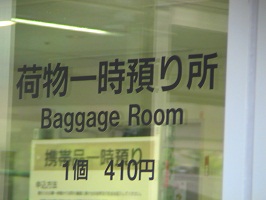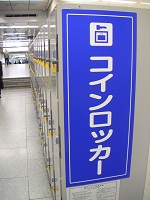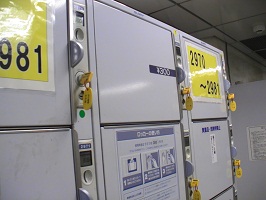Chapter 6 How to get around the town
Objectives (what you should be able to do in this chapter) and
Evaluations:
| 100 levels (Beginners):
Speaking and Listening Objectives:
To be able to get a help to buy a train ticket (short and long
distance).
To be able to find a way around the train station to get on a right
train to the destinations.
To be able to get a help to get off at a right station.
To be able to get a help on the street to get to the destination.
To be able to ask how long it will take from one place to the other and
its vicinity.
To be able to express existence.
To be able to ask/tell a location of items, people, and places around
the town (building and cities).
To be able to ask for a direction when you get lost.
To be able to use Ko-so-a-do words for places and directions.
To be able to take a taxi and ask you to take back to a hotel or a
destination.
To be able to use various questions words.
Writing and Reading Objectives:
To be able to understand and write a direction how to get from one place
to the other.
How you will be evaluated?
Required items: a web camera with a microphone and a whiteboard with a
black pen (or a thick black pen and paper).
First, you will be asked to scan your room,
on and under the desk and chair, and compute area with your web camera.
If I have not met you in person, I will ask you to show me your student
ID (or any photo ID). All the instructions will be done in Japanese
using the Classroom Instructions in the chapter 0.
No English is allowed to be spoken by a test taker unless the instructor ask
you to do so. All the test has to be completed in 10 minutes so f
you cannot respond to a question in several seconds, please say "すみません、わかりません
or わすれました。 つぎ おねがいします"
Speaking and Listening Skills: Written situations
will be shown for you to act out the situations with the instructor.
Please be able to understand what a ticket clerk or a person on the
street (the instructor plays these roles) would
say and be able to play "you" part/role in the sample
conversations below so that you can act out the situations with the
instructor to buy train/bus ticket and find your way to a destination.
Please practice with the video practices as well. Situation will
be similar to the dialogues in the text and sample situations that you
were asked to create as assignments.
Reading and Writing: You will be asked to
write some phrases or Kanji (please follow stroke orders of each letter/Kanji
characters). Also you will be asked to read some tickets and/or reading passages written in Japanese aloud to the
instructor. After reading them, you will be asked to answer in
Japanese or English to show your reading comprehension.
|
200 levels (Intermediate): The test needs to be
taken by Thursday of the week.
The same as above but make sure you will include all the grammar
structures introduced in this chapter.
Pick 20 new kanji on your own and submit the
list (Kanji, its meanings, & kana writings) to the instructor. You
can chose them from the sample conversation, writings, internet search,
etc. |
Click here for the Chapter 6 Kanji
(Please refer to the kanji glossary as well.)
Click here
(train station)
for the conversations recorded by previosu students.
Click
here (on the street) for the conversations recorded
by previosu students.
Direct Link:
https://appserv02.uncw.edu/tealvision/player.aspx?VID=d6%2bv0v7o6SE%3d
Hours and Minutes and Commuting
Review Chapter 2 "Sample Conversation 2: Time Expressions"
Click here to practice hours and minutes
with transportation
Learn about the differences between
goro-kurai/ ごろ&くらい and
ちかい&とおい
Sample Conversation 1: At Train Station (Buying a short distance
ticket)
Vocabulary Glossary Key Word "train
short distance"
View this video first to understand how to buy a local
ticket.
https://www.youtube.com/watch?v=I3ZK6Wa2D2E
Imagine you are at a train station, going to Shin Osaka. Have
a simulation in your mind and remember the steps from how to find how much it
will const to getting to the destination.
In traveling a short distance: You have to first buy a ticket
from a machine.
You have to look at the map above the ticket machine to determine how
much it would cost to your destination. A lot of signs are also
written in English in Tokyo but at a local city, the signs are all in
Kanji. If you cannot find out how much the ticket costs to go, for
example, to Osaka, ask a stranger for help at the ticket
machine and find out how much you have to pay. Read the note below
for more information.
Audio Files for Listening and
Speaking
|
You:
すみません。ちょっと、おうかがい しますが、
ここから しん大阪まで いくらですか?
|
Excuse me, but…How much is it to Shin-Osaka? |
A stranger:
しん大阪まで ですか? 480円です.
|
To Shin-Osaka? (it is) 480 yen. |
You:
どうも ありがとうございます。
|
Thank you very much. |
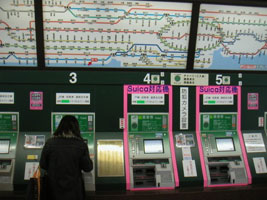
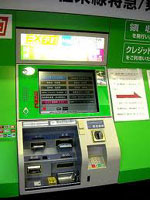
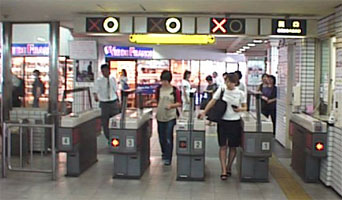 |
Now, you need to find out where to go to catch the next train to
Shin-Osaka. It is best to ask a station worker (SW) in uniform near the gate
machine as you see in the photo below (the two ladies in navy blue
uniform with a hat on. Please see the photo below and videos in the
"Break Time" to visually understand what I am talking about. Notice
the kanji for entrance 入口 (いりぐち) and exit 出口 (でぐち) to find which
machine you have to go through to enter the station.
You have to go through from 入口 (いりぐち). When you arrive
at a destination and exit the station, you have to go through the
machine which says 出口 (でぐち). It sometimes has/shows just an arrow
(no kanji word) and a stop
sign (see the photos below). You have to use the one which has an
arrow that indicates which one
you should use to go (enter or exit the station). It just means "Go through this path."
You may see "O" and "X" marks above the machines as you see in the photo above , some gates
automatically changes
the entrance and exit signs as people approach. The two machines
on the left in the photo above (on right) shows they are exits since you
see O but two people are approaching so They are about to change the
signs to "X" . Third one from the left is clearly "X" since a lady
has already fed a
ticket into the machine so you have to wait for her to go through. Modern technology confuses us
sometimes. You may be dancing (or you may see people dancing) with
the machines when many people are coming in and out trying to dodge
people.
If you are using JR pass, you cannot use the machine since it is just a
plain paper pass so you cannot feed it into the machine.
You have to show the pass to a station worker at a window near the machines to enter or
exit. A station worker is always at the ticket feeder machines. In
the above photo (on right) you can see a small box office of a station worker on
the right (hidden in this photo). |
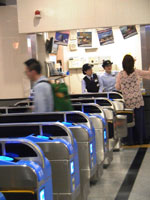
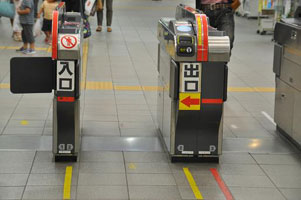
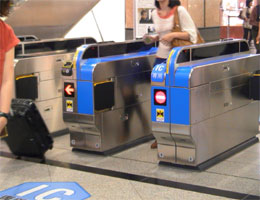 |
Now, you approach a station worker at the ticket feeder machines and
ask:
You: すみません。 次のしん大阪行きは 何番線ですか?
|
Excuse me.
What platform number is the next train to Shin-Osaka? |
SW:
次のしん大阪ですか。
新快速でんしゃは 6番線ですが、 快速は 1番線です。
|
The next train to Shin-Osaka (echo)? Shinkaisoku Express train is platform #6
but Kaisoku Express is the platform #1. |
You:
どちらのほうが はやいですか。
|
Which one is faster? |
SW: 新快速 (のほう)が はやいです。
|
Shinkaisoku is faster. |
|
You: 新快速は しん大阪に とまりますよね? |
Shinkansoku stops at Shin-Osaka, (I am pretty sure) right? |
|
SW: はい、とまります。京都を 出て、次の次の駅です。 |
Yes, it does. (It is) the next station after the next after leaving Kyoto. |
|
You:
新快速で ここから (しん大阪まで) 何ぷんくらいですか。 |
How long/how many minutes (is it) from here by Shinkaisoku (to Shin-Osaka)? |
SW:25ふんくらいです。
|
(it is) about 25 minutes. |
You:
ありがとうございました。
|
Thank you very much. |
|
Other useful words: 上り(のぼり)and 下り(くだり) |
上り is toward Tokyo.
下り is going down away from Tokyo
|
Note: There are different types of trains such as Super Express,
Express, Semi-Express, and Local. Long-distance express trains has names
such as のぞみNozomi, こだまKodama, ひかりHikari for Shinkansen Super Express trains.
のぞみ does not stop many stations, thus it is the fastest Shinkansen and you cannot
take it with JR pass (consider that のぞみ
is like a business class) , then ひかり and こだま.
There is a bargain ticket of taking こだま but it may take twice the time to get to a destination
than Hikari since Kodama usually stops every Shinkansen stations and you have to
fill out a form in Japanese to get the bargain.
The express train to go to
関西空港(関空)Kansai Airport from Kyoto is called 関空特急はるかKankuu Tokkyuu Haruka. See more
details in the Break Time. As for the short-distance trains in the JR line in Osaka
and Kyoto area, the fastest express train is called 新快速Shin Kai Soku (densha).
The next fastest is 快速Kai Soku (densha) and then local trains, which stop every
station, are called 普通Futsuu (densha). Another popular way for calling "express"
is 特急(電車)Tokkyuu (densha). Refer more to JNTO
http://www.japanrailpass.net/eng/en010.html
When I am in a hurry or do not feel like stopping many stations, I take
新快速Shin Kai Soku (densha) but it is always crowded and hard to find a seat to
sit down. So when I want to sit down and do not mind stopping a bit more
stations and taking a bit longer, I usually take 快速Kai Soku (densha). If I am traveling a short
distance, I take 普通Futsuu (densha) and sit and enjoy the view and people.
People watching on the train is fun. You may find some unique/strange
Japanese. It amazes me that some are sleeping on the train pretty well but
they wake up when they get to the destinations. Amazing skill!
Sample Conversation 2: At Train Station (Buying a long distance ticket)
Vocabulary glossary key word "calendar"
Vocabulary glossary key word "train long distance"
View this
video first to understand
How to use JR Pass, to look at Shinkansen time
table, to look at a Shinkansen reserved ticket, and more
https://www.youtube.com/watch?v=NKnyw-xFTfk
When you are traveling a long distance, it is the best to use
JR Shinkansen bullet train. If you are taking a round trip, for
example, between Kyoto and Tokyo, one-week pass is about the same
price buying a round trip ticket . There are some restrictions but you can reserve a seat
on Shinkansen with the JR pass
without any extra fee.
Read and see a video for more details at the Break Time.
Here is a sample conversation at みどりの窓口(まどぐち)to buy a long distance
ticket. MMC= みどりの窓口(まどぐち)clerk.
Audio Files for Listening and Speaking
|
You:
すみません。 これで(showing the JR pass) 京都から 東京までの していせきを おねがいします。出発は 6月22日の あさ10時ごろ です。
|
Excuse me. Please (let me have) a reserved seat from Kyoto to
Tokyo with this (JR pass). The departure is around ten in the morning on
June 22nd. |
MMC: 6月22日の あさ10時ですね。おうふくですか。 かたみちですか。 きんえんですか。 きつえん ですか。
|
(It is) 10 a.m. on June 22nd (echo), right? Round trip or one way?
Non-smoking or smoking? |
You:
かたみちの きんえんせきを おねがいします。
|
(Let me have) one way non-smoking, please. |
MMC: あさ 10時6ぷん発 の のぞみ220号と 10時9ふん発の こだま646号が ありますが...。
|
(We have/ there is) Nozomi #220 departing at 10:06 and Kodama #646
departing at 10:09. |
You:
じゃ、10時6ぷん (発) の のぞみを おねがいします。 クレジットカードは つかえますか (だいじょうぶですか)。
|
Well then, Nozomi #220 departing at 10:06, please. Can I use a credit
card (Is a credit card OK)? |
MMC: はい、つかえます。 6月22日 ごぜん 10時6ぷん発の のぞみ220号ですね。しょうしょう おまちください。
|
Yes, you can. (it is) Nozomi #220 departing at 10:06 , right?
Please wait a moment. |
You:
はい。
|
Yes. it is. |
MMC: (After a bit) おまたせしました。13,220円に なります。
|
Thank you for waiting. (It) comes to 13220 yen. |
You:
じゃ、これで おねがいします。(handing a credit card)
|
With this (a credit card), please. |
MMC: こちらに ごしょめいを おねがいいたします。こちら (特急券と) 指定席券に なります。 ありがとうございました。(bow)
|
Please sign here. This is (an express ticket and) reserved seat
ticket. Thank you very much. |
|
Make sure the ticket date and time are correct. When you use the
ticket, find out which platform you have to go. Shinkansen
information shows both Japanese and English but if you want to ask a
station worker at the ticket feeder machine, here is the phrases.
If you are using the JR pass, you have to go through them anyway since
the JR pass cannot be fed into the gate machine. |
You:
すみません。 これ(showing the reservation ticket or saying 10時6ぷん(発) の のぞみ220号は 何番線ですか。
|
Excuse me. What platform number is this (the ticket or
saying Nozomi 220 at 10:06)? |
SW: えーと、18番線です。
|
Let me see... platform #18. |
You:
ありがとう。
|
Thanks. |
|
When you are using escalator in Japan especially at a train
station, you need to stand on one side. Just follow the person/
crown to determine which side you need to stand so that people in a
hurry can run through the escalator to catch a train. |
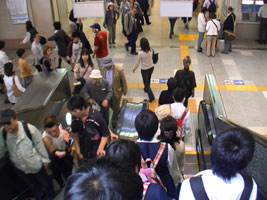 |
When you go to the platform, you will see a train information as
you see below. The photo on the left is the platform of local
trains, and the photo on the right is Shinkansen platform. The
gate to Shinkansen train is often insides the local train station. So
you sometimes have to go through two gates to get to Shinkansen platform.
|
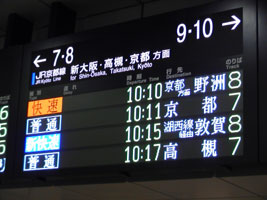
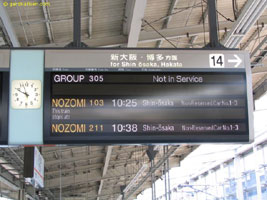 |
The local trains sometimes have "Women Only" trains. They
are well marked so if you are a guy, you want to avoid getting in it. The sign
also is written in English so you cannot pretend that you do not
understand Japanese writings...
|
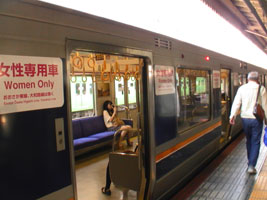
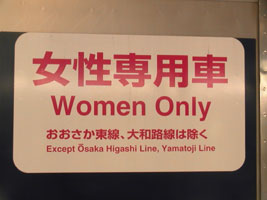
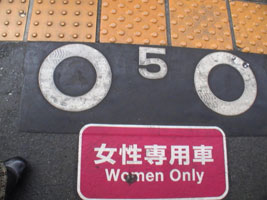 |
Sample train tickets
Vocabulary glossary key word "train long distance"
|
I was going from Kyoto to Kozoji station by Japan Railway (JR). I
had to get off at Shinkansen at Nagoya and then take a local train to go
to Kozoji. The first ticket below is the Shinkansen ticket. When you
go out of Shinkansen station gate at Nagoya, the machine takes away the
Shinkansen ticket and you are left with the second one (the local
ticket) below. If you do not have the local ticket, you can not use the
transfer gate to local trains. You have to go out of the station and
purchase a local ticket to the destination (in this sample , it
is Kozoji). Here is the Shinkansen train ticket from Kyoto to Nagoya.
|
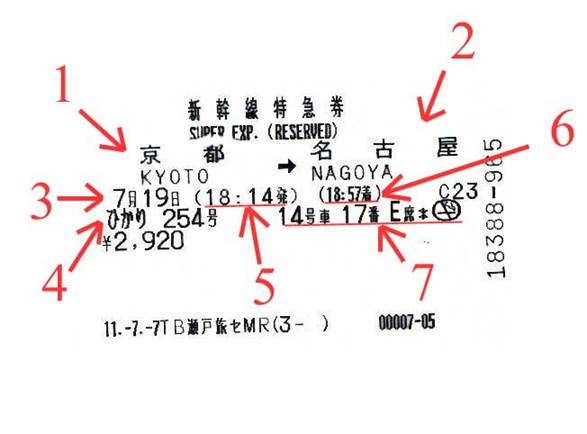
# |
Bullet train ticket from Kyoto to Nagoya
新幹線特急券
(しん・かん・せん・とっ・きゅう・けん)
1: 京都 Kyoto (Departing station name)
2: 名古屋 Nagoya (Arrival station name)
3: 7月19日 July 19th
4: ひかり243号(ごう)Hikari 243
5:(18:14)発(はつ)6:14 p.m. departing
6:18:52着(ちゃく) 6:52 p.m. arrival
7:14号車(ごう・しゃ)17番(ばん)E席 (せき)Car #14, seat #17 E
|
|
This is the local train fare ticket from Kyoto to Kozuji.
You are usually given two tickets. One is for Shinkansen express
ticket and the other one is a fare ticket. You can take local trains
from Kyoto to Nagoya and then to Kozoji (in this case) with all the
local trains but you have to transfer many times and it will take a
while to get to the destination (I have not idea how long since I have
not tried it. If you do, good luck. You will get there some day.) |
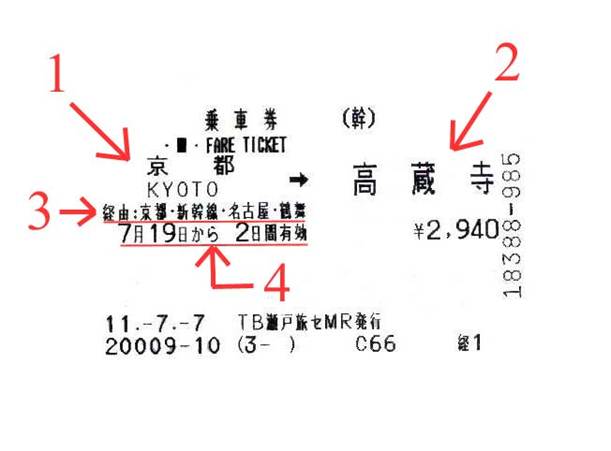 |
Local train ticket to Kozoji
乗車券 じょう・しゃ・けん
1: 京都 Kyoto, Departing station name
2: 高蔵寺 Kozoji, Arrival station name
3: 経由:京都・新幹線・名古屋・舞鶴 Bound for Kyoto, Shinkansen, Nagoya, Maizuru
4: 7月19日から 2日間有効(ふつか・かん・ゆうこう) The term of validity of the ticket: From
July 19th, good for two day
|
The below is a train ticket from Nara to Kyoto by Kinki Nihon Railway
(近畿日本鉄道 きん・きに・ほん・てつ・どう)
|
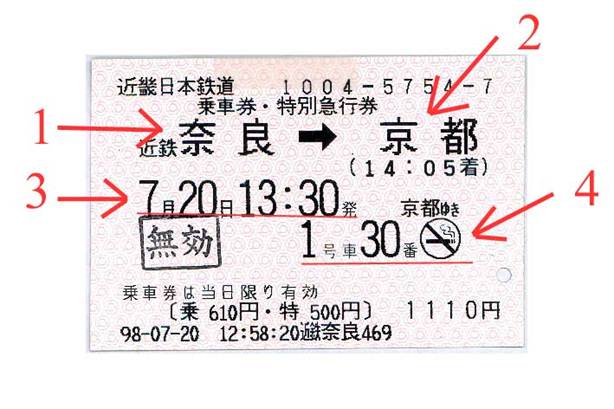 |
乗車券 じょう・しゃ・けん 特別急行券 とく・べつ・きゅう・こう・けん
1: なら Kyoto (Departing station name)
2: 京都 Kozoji (Arrival station name)
3: 7月20日 13:30発 July 20th departing at 1:30 p.m.
4: 1号車30番 Car#1 seat#30
You see 無効 むこう (invalid) stamp under the date July 20th since I
asked for it at the manned booth when exiting at the train gate machine.
|
The below is a regular local train ticket.
|
|
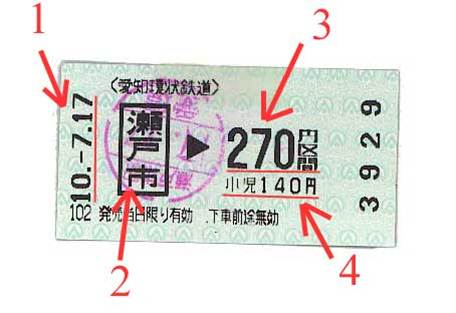 |
1. July 17th (date of purchase, It is only good on this date.)
2. 瀬戸市 せ・と・し (Departing station name)
3. 270円 えん (fare price for adult)
4. 小児140円 しょう・に 140えん(fare price for children under 12 years old.) |
If you put the ticket to a ticket feeder machine when you exit, the
machine eats it. You have to have the ticket when you exit the
station; otherwise, you have to pay some penalty if you lose it. If you
want to keep the ticket as a souvenir, you can take the ticket to a station worker at the gate machine and ask for 無効印 (むこういん). Simply say
"無効印 (むこういん) おねがいします" before you feed it to the machine. They
will stamp the kanji word 無効 on the ticket as you see in the picture above
(the second picture from the bottom from Nara to Kyoto) under the date, July 20
(7月20日).
|
Sample Conversation 3: At the City Bus
Information Center (Buying a 0ne-day bus pass)
Vocabulary glossary key word "bus"
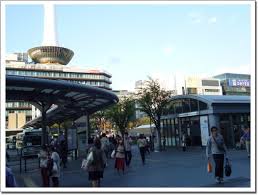 |
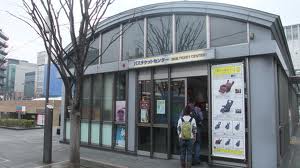 |
You are looking for the JR Kyoto Station Central Entrance Bus
Information Center. You are now at the JR Kyoto Station. Ask someone (the best person is someone
in uniform at the station.)
Kyoto City
web site:
http://www.city.kyoto.jp/koho/eng/index.html
City Bus information:
http://www.city.kyoto.jp/koho/eng/access/transport.html
Bus route information :
http://inst.uno.edu/japan/docs/bus_navi_en.pdf
Audio Files for Listening and
Speaking
|
You:
すみません。 市バスのインフォメーション センター(そうごう あんない じょ)は どこですか。
|
Excuse me. Where is the City bus information center? |
A stranger: えきの まえですよ。 えきの そとです。 あちらの ほうですよ。
|
(It is) in front of the station. (It is) outside the station.
Over that way. |
You:
どうも。
|
Thanks. |
|
At the Kyoto City Bus Information Center
|
You:
すみません。 市バスの いちにち じょうしゃ けん (一日乗車券)にまい ください。
|
Excuse me. (Let me have) two tickets of one-day ride City bus
pass. |
Bus office worker: あちらで おもとめ ください。
|
Please buy it over there. |
You:
えっ? あっ、すみません。 あっちですか。 どうも。
|
Oops. Oh, sorry. Over there? Thanks. |
You:
すみません。 市バスの いちにち じょうしゃけん (一日乗車券)にまい ください。
|
Excuse me. (Let me have) two tickets of one-day ride City bus
pass. |
Bus office worker:
いちにちですか。 ふつかですか。
|
One day? Two days? |
You:
いちにちです。クレジットカードは つかえますか。
|
(It is) one-day . Can (I) use a credit card? |
Bus office worker: いえ、クレジットカードは だめなんです。 げんきんで おねがいします。 いちまいですか?
|
No, the credit card is no good. Cash please. One ticket? |
You: いえ、にまい ください。 じゃ、これで。(Handing over 1000yen bill)
|
No, two, please. Well, with this (cash). |
Bus office worker: はい、こちら、いちにち じょうじゃ けん (一日乗車券) 2まいに なりなす 。 ありがとうございました。
|
Here (you go).
This is (these are) the two one-day pass. Thank you very much. |
You:
どうも。
|
Thanks. |
Note: Bus and subway in Kyoto: Bus and subways in Kyoto to
go around tourist spots are operated by Kyoto city (not JR, so you cannot use JR
pass). The most economical way to travel around Kyoto city is to buy a
one-day pass of bus or train. One-day Bus Pass
一日乗車券(いちにち じょうしゃ けん) is 500 yen (one ride
within Kyoto is 220yen) so if you use the bus three times or more, it becomes
more economical way to pay for a bus ride.
The One-Day Subway pass is 600 yen. They will give you a map when
you buy the pass. There is also the bus and subway combined one-day
pass. Adult is 1200 yen for one day, and 2000 yen for a consecutive two
days.
Intermediate Grammar here are :
Comparative/superlative より、ほう、ほど、おなじ、いちばん
Potential forms of verb
Sample Conversation 4: Getting On and Off the Trains (or bus)
Vocabulary glossary key word "train
on-off"
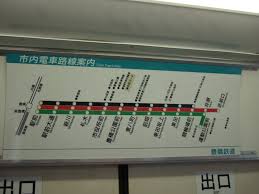 |
 |
Japanese trains are always in time unless there is an accident
or adverse weather. If you want to make sure if the train coming in or
already stopped at the station, goes to your destination, here is how to
ask a stranger or a station worker (えきいんさん) but you need to do this fast
since the train leaves on time. Inside the train, there is a train line
route map or sometimes digital map or information as you see in the
photo above.
Audio Files for Listening and Speaking
|
You:
すみません。つぎのでんしゃ(if the train is already
at the platform,
you say このでんしゃ) は
しんおおさかに いきますか(or
とまりますか)?
|
Excuse me. Does the next train (coming in) go to (or stop at)
Osaka? |
Eki in: はい、とまりますよ。
|
Yes. it does. |
You:
どうも。
|
Thanks. |
|
You got on the train and want to find out if the next stop is your
destination Shin Osaka. You can say
ここは しんおおさか ですか?when
you are arriving at the Shin-Osaka station but you have only a minute to exit
the train so you want to find it out beforehand. |
You:
:
つぎの えきは しんおおさかですか?
|
Is the next station Osaka? |
A stranger on the train: ええと...、いえ、つぎの つぎが しんおおさかですよ。 あと ふたえき です。
|
Let me see... No, the train after the next is the Osaka. Two
more stations |
You:
ありがとう ございました。
|
Thank you very much. |
Kyoto City Bus
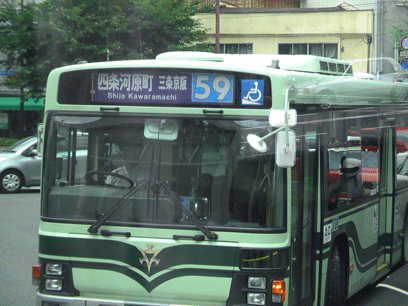 |
Make sure you ride on the bus of this color and design. If you
ride on other city bus (they are usually long-distance bus), the one-day
bus pass does not work on other type of bus so you have to pay.
The front of the bus shows the bus number and the destinations.
You ride from the back and exit from the front (the exit near the
driver).
Study more about how to ride the bus below. |
Read about the bus in Kyoto (how to ride a bus, different
passes, fares, maps, etc.)
http://www.city.kyoto.jp/koho/eng/access/transport.html
first. You will get on the bus from the back. You have to pay or
show a bus pass when you exit. The first time you use the
pass, you have to feed it through a machine next to the driver to get
the today's date stamped. You cannot choose a date. It will
stamp the date when you feed the card through the machine. If the
pass is good for one day, you can use only on the date stamped. Once
it is stamped, you just show the stamped date of the pass to the driver when you get
off.
|
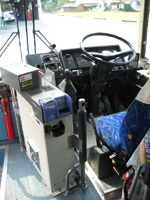
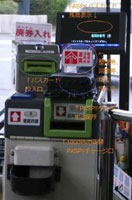
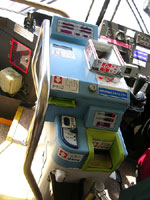
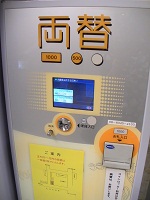 \ \ |
Some machine are very confusing so ask the driver which slot you
should feed the pass.
You have to have the exact change of the fare. If you do not have
changes, you should go up to the driver and use the machine to change
from a bill to coins. Look for a sign 両替え(change) on the machine.
Although you should not take much time of the driver, you can quickly
ask the directions. Some drivers are nice and
others are rough (maybe he was having a bad day) in my experiences. Please ask them during a bus
stops during waiting at t traffic light changes or passenger getting on
and off at a bus stop. They do not like to see you walking on the bus while the
bus is moving since it is not safe. Please hold onto a pole or
handles hanging from the above.
|
You: (You need to get a date stamped on the one-day pass)すみません。 これは どこに...
|
Excuse me, where does this (go, put in)...? |
Driver: ここ..
|
Here... |
You: (As
you are getting off, quickly ask )あ、すみません。 清水寺は どっちですか。
|
Oh, sorry. Which way is the Kiyomizu Temple? |
Driver: 清水寺は あっちのほう。
|
Kiyomizu Temple is that way. |
You: ありがとうございました。Say this quickly as you getting off, or
standing
aside for other passengers to pass you and get off. You do not want to
hold up the line of people or the driver.
|
Thank you very much. |
Other words you will see around ticket machines on the bus:
両替え りょうがえ Change
大人 おとな Adult
小児 しょうに child |
|
Break Time ひとやすみ
Take a break and watch some videos and visually understand about the ticket
machine and gate to go into the station.
Train
Shinkansen time table from Kyoto to Tokyo
http://www.tabi-o-ji.com/shinkansen/schedule/result.php
Travel In Japan: This video shows everything around the in and out
the train station.
http://www.youtube.com/watch?v=n-JgSz2N0QI
How to buy ticket and Suica prepaid card, etc. At the
end of the video is the Harajuku station.
http://www.youtube.com/watch?v=025fgD38elw
Cleaning lady of Shinkansen train at the last stop:
http://www.youtube.com/watch?NR=1&v=wHznLv4ucCI&feature=endscreen
JR Pass
If you are planning a long distance travels around
Japan, purchasing a Japan Railway (JR) pass is recommended. You must
buy a Boucher from a travel agent or on-line before you enter Japan
since it is only
available to foreign nationals and a permanent resident status holder in a foreign
nation. You can buy by a week, two weeks, etc. That enables you to
travel by Shinkansen bullet trains (except のぞみShinkansen). When you get to
Japan with a boucher, first you have to find an office to change the
boucher to a real JR pass (find out the locations from the JR
pass web site below or the information comes with the boucher). When you
exchange the boucher to the real pass (or after you obtain a JR pass) you can
reserve a
seat if you like (there are non-reserved seats on Shinkansen trains), you need to go to a みどりの窓口(まどぐち)at
a Shinkansen station to reserve a seat with the JR pass.
During our program, the only trip we use JR is when we go to Tokyo and Nagoya.
Other local field trips are done by city bus, train, or subway. (not JR operated
transportation). If you need to just buy a one way ticket to Tokyo, it is
cheaper to buy one way ticket than buying a JR pass. The round trip
between Kyoto and Tokyo is about as much as a one-week JR pass.
JR pass web site:
http://www.japanrailpass.net/
To purchase the JR pass:
http://www.japanrailtravel.com/?gclid=CPeW9pOtyLcCFScV7AodyB0AHg
How to travel with a JR pass
http://www.youtube.com/watch?v=4TwbgtCeb6E
Bus
Kyoto buses: Try to catch some kanji (entrance
入口、exit 出口), bus number (in front of the buses) , and the destination. It
comes and goes very fast!
http://www.youtube.com/watch?v=17xTDPBf6uA
Inside Kyoto bus
http://www.youtube.com/watch?v=WSyIQxYhaUk
Buying a subway ticket in Osaka
http://www.youtube.com/watch?v=m3myuDQ8w40
If you are taking a bus that goes outside Kyoto for example, you need to pick up a number
ticket (せいりけん 整理券) to determine your fare
http://www.youtube.com/watch?v=evyNNdtcuOc
About the bus in Kyoto (how to ride a bus, different
passes, fares, maps, etc.)
http://www.city.kyoto.jp/koho/eng/access/transport.html
This is a sample of 整理券 せいりけん that you have to pick up from a machine
when riding a long distance bus. It just has a number on it.
If you are riding from the very first bus stop, there is no number
ticket so when you pay, you look at なし(no ticket)。If you forget to pick
it up, you have to pay the highest amount. The fare is shown under the
numbers.
|
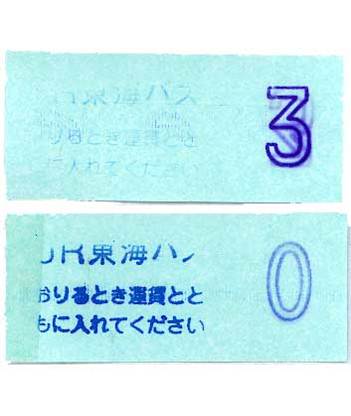 |
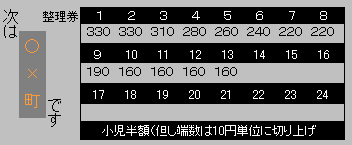 |
Note: Sinkansen station in Kyoto has dozens of souvenir shops on
the ground floor. When go to the platforms, there are kiosk shops where
you can buy drinks and boxed food (おべんとう). Enjoy the local boxed lunch
in the area. You can also buy drinks and boxed lunch inside the Shinkansen
train but it cost a bit more so I recommend you to stock up your drinks and food before
you ride on Shinkansen trains. The price of souvenir items seems to be about the
same price as local stores. As you pass a different Shinkansen station,
they re-stock different souvenir items. My favorite souvenir sweets is ういろ in Nagoya on
the way to Tokyo so, once we pass Nagoya station, I always wait for a lady with
a cart coming to sell ういろ. Some souvenir items and specialty Shinkansen box
lunch are only sold inside Shinkansen trains such
as a key chain of the train. I usually buy a boxed lunch at a kiosk on
the Shinkansen station platform. Or I buy まくのうち べんとうon
the Shinkansen.
まくのうち べんとう
is a traditional Japanese style food with simmered vegetables so
you may not care for it... They do have sandwiches and other variety\ies
as well. I sometimes even get off at some Shinkansen station just to buy a lunch box of the
area (駅弁・えきべん). I collected some of Eki ben containers as you see below.
|
My hometown is famous for たこ (Octopus). The bento box is called
ひっぱりだこ (this word ひっぱりだこ also means "popular (person/people)" . It is
a pun.) It is my pen stand in my office now. The Kobe Beef Bento is
served in a regular square box. |
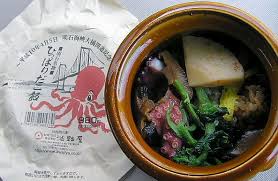
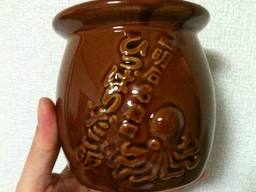
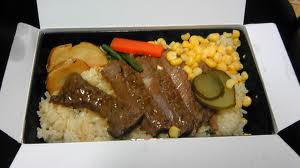 |
|
You have to go to Iwate or Akita area (northern part in Honshuu) to buy the
Kokeshi Bento. Kokeshi is a popular souvenir of the wooden doll from the
northern part of Japan where forestry is one of the industries. I have not tried Daruma bento since I have not
been to Takasaki area. |

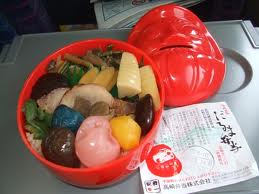
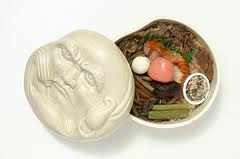 |
There are much more! See this site:
http://justbento.com/handbook/bento-culture/all-about-ekiben-japanese-train-station-bentos
|
Sample Conversation 5: Finding a correct exit at the station
Vocabulary Glossary Key Words “pronouns”
Vocabulary Glossary Key Words “question words”
Grammar:
“ko-so-a-do series:
Grammar:
Click here
to review Interrogatives (Question words)
JNTO Practical Travel Guide
Print out the following before you leave US:
Kyoto walk,
Osaka,
Nara walk
Grammar Glossary
Key Words “existence-locations”
Suppose, you have arrived at a destination by train. Now you need
to find out the way to Osaka Castle. "Ekiin" means "station worker." The big train stations have several exits.
On a station platform, there is a sign which list a landmarks and show
(with an arrow) you which direction/exit your should go. But it is
sometimes difficult to find it in a congested station. So let's learn to
ask a station worker or a stranger (sometimes a stranger does may be new
to the area).
Audio Files for Listening
and Speaking
|
You:
すみません、大阪じょうは どちら(何番出口、どの出口) ですか。
こちらですか。
|
Excuse me. Which way (exit number, which exit) is Osaka castle?
(Is it) this way? |
Eki-in:
南三番出口です。 あちらです。
|
(It is) the south #3 exit. That way. |
You:
ありがとうございます。
|
Thank you very much. |
|
After getting off the train, trying to find the right exit
to Oosaka Castle. |
You:
すみません、大阪じょうは どちらのほう ですか?
|
Excuse me. Which way/direction is Osaka Castle? |
A stranger:
あちら (の ほう)
ですよ.
ここを まっすぐいって みぎに まがると
すぐですよ。
|
(It is) that way. Go straight here and if (you) turn right,
(it is) right there. |
You:
ありがとうございます。
|
Thank you very much. |
Sample Conversation 6: Finding a way around town
Vocabulary Glossary Key Words “question words”
Vocabulary Glossary Key Words “buildings” “buildings-places”
Grammar : “existence-locations”
Click here to learn and practice "locations"
Location =
reference +
の
+ positional word
If you are looking for a post office, you can ask strangers to
find a way there. Even I sometimes ask multiple people to find my
way to a destination.
Audio Files for Listening and Speaking: Listen to the
Coversation 5 above.
|
You:
すみません。 このへんに ゆうびんきょくは ありますか。
|
Excuse me. Is there a post office around here? |
A stranger 1: 次の こうさてん( or しんごう)を わたって、ひだりに ありますよ。
|
(if you) go across the next cross road (or traffic light) , (there is one) on the left. |
You: どうも、ありがとうございました。
|
Thank you very much. |
|
You walked across a traffic light crossing but did not see a post office.
So you ask another stranger. Find another person who may help you and
say: |
You:
すみません。 このへんに ゆうびんきょくは ありますか。
|
Excuse me. Is there a post office around here? |
A stranger 2: あの駅の ひだりに ありますよ。
|
There is (one) on the left of the station over there. |
You:
どうも、ありがとうございました。 and walked toward a station to find a post office.
|
Thank you very much. |
The logo of the post office is: Now they are changing the logo.

|
|
Other land mark signs:
Shrine Temple Temple
|
|
You:
ここは ゆうびんきょくですか。
|
Is here a post office? |
A stranger: はい、そうです。
|
Yes, it is. |
Assignments in Japan
Submit all the above to me in a flash drive at the farewell dinner on the last day of the
program. (Do NOT send it
to my UNCW e-mail since it may jam up my e-mail.)
1.
Kanji and Katakana hunting: Take at least 20 photo each
of kanji and Katakana around town, T-shirt, snack packages, etc. Please
include the surrounding background to show where the kanji was found to show the
context. Save them as the meaning of the kanji. Example: 茶
Save the file as "green tea" if you do not know what it means but you see
them often, just number them with where you saw them such as street 1, shop 2, restaurant 3, etc.
2.
Record your conversation with Japanese at the following situation
(a) train station; b) restaurant; c) fast food restaurant, d) a way to a
destination of your choice or a shopping at the temple flea market; e) any other
situation.
Even if you know how much you have to pay for a ticket, you can talk with a
station worker or a stranger to find out the answer. Submit the required
number/situation as indicated in the course calendar. For
6th or additional recordings, you can record an announcement at a train station,
glossary store, etc. (if the recording is not good, I will ask you to
submit again). So the 6th recording does not have to have your talk in Japanese.
3.
Jinglish (Japanese version of English) , interesting signs and objects: Take at
least 10 picture
of some funny Japanese English on a T-shirt, packages, etc. or a signs around
town. I like a sign that shows bowing to people.
Enjoy your stay in Japan !!!!!!!






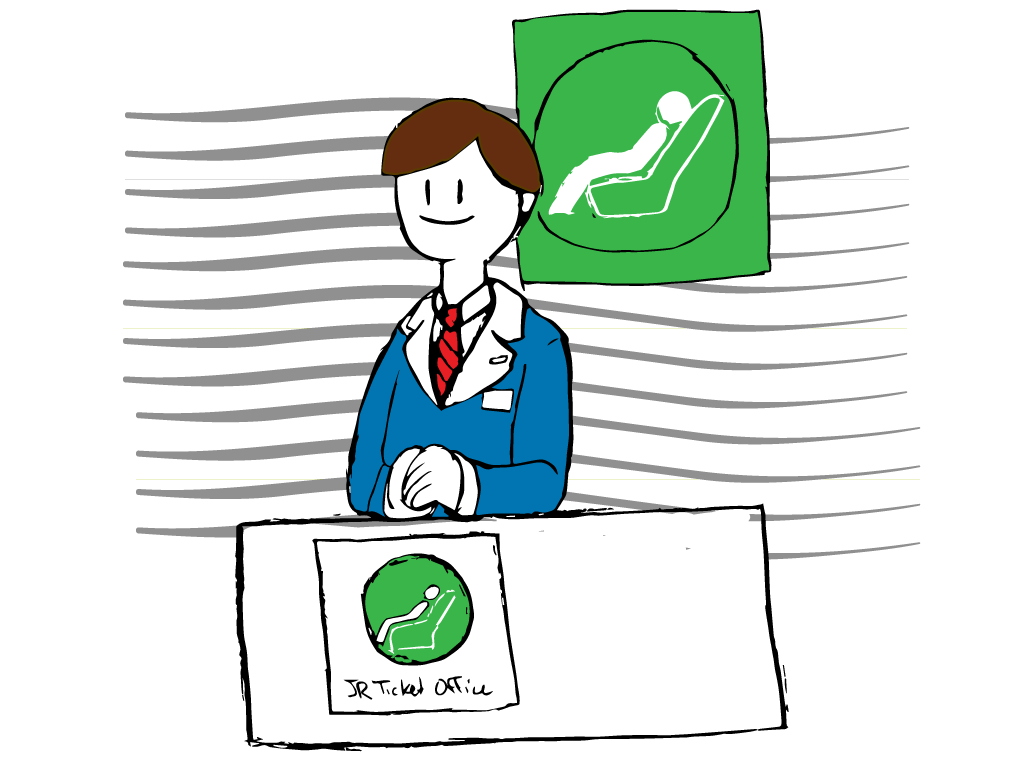
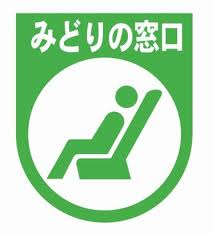
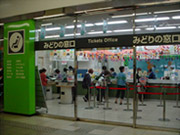


















 \
\ 








 Temple
Temple
